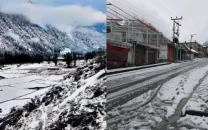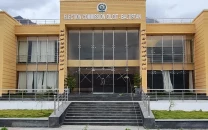Looming danger: Melting glaciers heighten flood risks in Gilgit-Baltistan
Highest temperature recorded in Gilgit was 42 degrees centigrade on Monday.

Houses located alongside Gilgit River from Gilgit town up to Baseen area are under a threat of flooding in coming days as the volume of water continues to increase.
According to the meteorological department, the highest temperature recorded in Gilgit was 42 degrees centigrade on Monday and dry weather is expected to prevail in coming days.
Pakistan has the largest collection of glaciers in the world among countries outside the North and South Pole regions. These glaciers are heavily-concentrated in the three great mountain ranges of Karakoram, Himalaya and Hindukush, situated in the northern parts of Gilgit-Baltistan and Chitral.
“There are chances that water will get into our homes if conditions remain the same,” said Khursheed Ahmed, a resident of Gilgit whose house is at the bank of Gilgit River. “But we are monitoring the situation closely since the last 24 hours,” he added.
The nullahs (ravines) in most areas where Karakoram Highway (KKH) passes through have overflowed, disturbing traffic. Passengers travelling in smaller cars seem to be the most affected.
“The journey from Mansehra to Gilgit is very risky,” said Junaid, a student who had come to Gilgit from Babusar Road with his friends. “On several occasions during our journey, we had to push our car to cross the tributaries flooding the roads.”
In Gojal Valley, a number of nullahs have flooded the routes, adding to the misery of commuters.
Saifur Rahman, a resident of Gilgit who visited the valley this weekend, said floods have damaged roads in a number of places, creating various problems. “The volume of water in the tributaries and ravines have increased manifold and it is difficult for a small car to pass through without breaking down.”
In 2010, G-B witnessed massive destruction when monsoon rains lashed the region. The area remained cut off from rest of the country for more than a month as KKH was swept away on several points by the overflowing water.
Published in The Express Tribune, July 1st, 2014.


















COMMENTS
Comments are moderated and generally will be posted if they are on-topic and not abusive.
For more information, please see our Comments FAQ